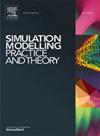在远程物联网网络中,针对具有低地轨道增强功能的无人机 MEC,采用新型节能、经济高效的任务卸载方法
IF 3.5
2区 计算机科学
Q2 COMPUTER SCIENCE, INTERDISCIPLINARY APPLICATIONS
引用次数: 0
摘要
远程物联网(IoRT)涉及部署在广阔且往往偏远地区的设备网络,收集数据并进行传输和处理。在这些网络中,无人飞行器(UAV)收集数据,然后发送到低地轨道(LEO)卫星进行处理。这些系统往往面临巨大挑战,特别是在任务卸载方面。传统方法通常依赖于静态路由和调度算法,这种算法不能适应不断变化的条件,通常会忽略恶劣或孤立环境中动态决策的复杂性,因此无法解决能效和延迟等关键挑战。在本文中,我们介绍了一种由三层架构组成的方法。第一层是 IoRT 计算层,使用深度 Q 网络(DQN)根据设备限制和任务紧迫性优化本地决策。第二层的特点是无人机作为移动边缘计算(MEC),它不仅处理数据,还决定是在本地处理任务还是将任务卸载到低地轨道卫星上,在此决策过程中使用了与理想解决方案相似度排序偏好技术(TOPSIS)。第三个低地轨道卫星层具有很高的计算能力,可处理卸载任务。仿真结果显示了显著的改进:与另一种方法相比,所提出的模型显示能耗降低了 14.73%,延迟降低了 23.13%,同时执行成本平均降低了 28.7%。本文章由计算机程序翻译,如有差异,请以英文原文为准。
A novel energy-efficient and cost-effective task offloading approach for UAV-enabled MEC with LEO enhancement in Internet of Remote Things networks
The Internet of Remote Things (IoRT) involves networks of devices deployed in extensive and often remote areas, collecting data for transmission and processing. In such networks, Unmanned Aerial Vehicles (UAVs) gather data, which is then sent to Low Earth Orbit (LEO) satellites for processing. These systems often face significant challenges, particularly in task offloading. Conventional methods typically rely on static routing and scheduling algorithms that do not adapt to changing conditions and usually overlook the complexity of dynamic decision-making in harsh or isolated environments, thus failing to address the critical challenges of energy efficiency and latency. In this paper, we introduce a method comprised of a three-layer architecture. The first layer, the IoRT computing layer, uses Deep Q-Network (DQN) to optimize local decisions based on device constraints and task urgency. The second layer features UAVs serve as Mobile Edge Computing (MEC), which not only processes data but also decides whether to process tasks locally or offload them to LEO satellites, utilizing the Technique for Order Preference by Similarity to Ideal Solution (TOPSIS) for this decision-making process. The third LEO Satellite Layer has a high computational capacity to handle offloaded tasks. Simulation results demonstrate notable improvements: compared to another method, the proposed model shows a 14.73 % reduction in energy consumption and a 23.13 % decrease in latency while reducing execution costs by an average of 28.7 %.
求助全文
通过发布文献求助,成功后即可免费获取论文全文。
去求助
来源期刊

Simulation Modelling Practice and Theory
工程技术-计算机:跨学科应用
CiteScore
9.80
自引率
4.80%
发文量
142
审稿时长
21 days
期刊介绍:
The journal Simulation Modelling Practice and Theory provides a forum for original, high-quality papers dealing with any aspect of systems simulation and modelling.
The journal aims at being a reference and a powerful tool to all those professionally active and/or interested in the methods and applications of simulation. Submitted papers will be peer reviewed and must significantly contribute to modelling and simulation in general or use modelling and simulation in application areas.
Paper submission is solicited on:
• theoretical aspects of modelling and simulation including formal modelling, model-checking, random number generators, sensitivity analysis, variance reduction techniques, experimental design, meta-modelling, methods and algorithms for validation and verification, selection and comparison procedures etc.;
• methodology and application of modelling and simulation in any area, including computer systems, networks, real-time and embedded systems, mobile and intelligent agents, manufacturing and transportation systems, management, engineering, biomedical engineering, economics, ecology and environment, education, transaction handling, etc.;
• simulation languages and environments including those, specific to distributed computing, grid computing, high performance computers or computer networks, etc.;
• distributed and real-time simulation, simulation interoperability;
• tools for high performance computing simulation, including dedicated architectures and parallel computing.
 求助内容:
求助内容: 应助结果提醒方式:
应助结果提醒方式:


